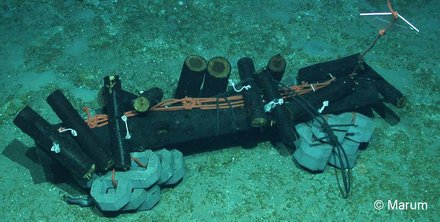Research Projects
FRAM Microbial Observatory
As part of the Helmholtz infrastructure program FRAM - Frontiers in Arctic Marine Monitoring, I co-lead and coordinate work on bacterial communities in the framework of a Molecular Microbial Observatory which is currently being established in Fram Strait.
ABYSS – Assessment of bacterial life and matter cycling in deep-sea surface sediments
The ERC Advanced Investigator Grant ABYSS (2012-2018) was aimed at developing a systematic understanding of abyssal sediment bacterial community distribution, diversity, function and interactions. Our goals in the project included the identification of key bacterial types in deep-sea sediments and the characterization of their role in organic matter remineralization at the seafloor, as well as developing a better understanding of links between the pelagic and benthic realms. The long-term observatory HAUSGARTEN presented a cornerstone of our work in the Arctic deep sea. During yearly research cruises we used the site for in situ and ex situ experimental work, in order to better characterize deep-sea bacterial diversity and function in a changing Arctic Ocean.
See our recent publication about Woeseiales bacteria in deep-sea sediments, and read more in this Behind the paper article.
Bacterial diversity patterns in deep-sea sediments
The deep seafloor below 200 m water depth covers approximately 65% of the Earth’s surface and therefore presents the largest continuous ecosystem on Earth, but also one of the least understood. Bacterial communities play an essential role for carbon and nutrient cycling in deep-sea sediments, and are thus an important component not only of benthic deep-sea ecosystems, but also of the global carbon cycle. Nevertheless, bacterial diversity and its distribution in deep-sea sediments of the world’s oceans remain largely unknown. My studies aim at developing a better understanding of bacterial diversity patterns and ecosystem functioning at the deep seafloor.
I specifically investigate patterns of bacterial community structure in an environmental and spatial context. Recently, we could evidence distinct energy-diversity relationships for bacterial communities in Arctic deep-sea sediments (Bienhold et al., 2012). I am currently expanding analyses to a set of globally distributed deep-sea surface sediments to understand which contextual parameters are important drivers for changes in bacterial communities at the global scale.
Ecology of wood falls in the deep sea
Chemosynthetic ecosystems in the deep sea (e.g., hydrothermal vents and cold seeps) present oases of life in an otherwise largely oligotrophic environment. Large organic food falls such as whale carcasses, wood and kelp can lead to the development of chemosynthetic environments in the deep sea which may act as stepping stones in the evolution and distribution of chemoautotrophic communities. Considerable effort has been spent on the exploration of hydrothermal vent and cold seep ecosystems as well as whale falls, but the role of wood falls as localized boosts of organic material to the deep seafloor remains largely unstudied. In the framework of the ESF EUROCORES EuroDEEP Project “Colonization processes in chemosynthetic ecosystems – CHEMECO” and the MPG-CNRS GDRE „Diversity, establishment and function of organisms associated with marine wood falls – DIWOOD”, we carried out wood colonization experiments in the Eastern Mediterranean deep sea to investigate the succession of colonization and the establishment of biogeochemical gradients at deep-sea wood falls (Figure 1). The aim of this study was to contribute to a better understanding of the microbial ecology and biogeochemistry of wood fall ecosystems and their role as biological and biochemical hotspots in the deep sea.

Expeditions
| 2014 | RV Polarstern, ARKXXVIII/2, Fram Strait, Arctic Ocean |
| 2013 | RV Maria S. Merian, MSM-29, HAUSGARTEN, Fram Strait, Arctic Ocean |
| 2012 | RV Polarstern, ARK 27-3, IceArc, Central Arctic |
| 2009 | RV Maria S. Merian, MSM 13-3, Eastern Mediterranean (wood colonization experiments) |
| 2008 | RV Meteor, M 76/3B, Congo fan (cold seeps) |
| 2007 | RV Pourquoi Pas?, MEDECO-2, Eastern Mediterranean (wood colonization experiments) |
| 2007 | RV Polarstern, ANT XXIII/9, Prydz Bay, Antarctic (Geophysics) |
| 2004 | RV Heincke, North Sea, student course, University of Bremen |
| 2003 | RV Heincke, North Sea, University of Hamburg |